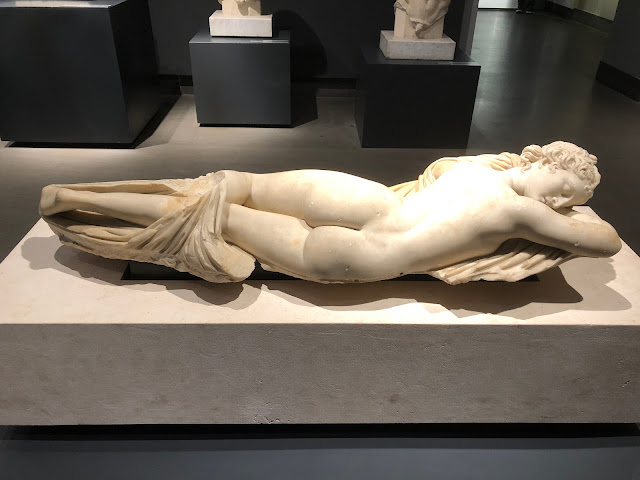【ローマ】マッシモ宮のローマ国立博物館② Roma - Palazzo Massimo alle Terma 2
ローマ国立博物館の2階にフロアに降りてくると、古代ローマ時代に作られた多くの彫像が展示されていた。
古代ローマの時代には、多くの大理石の彫刻が作られたが、それらの多くは、古代ギリシャからのコピー作品だった。
これは古代ギリシャの有名な彫刻家、ミュロンが制作した”円盤投げ”のコピー作品。
オリジナルはブロンズ像だったようだが、多くのコピーが作られて、現在ではそのうちの5点が見つかっているという。
When I came down to the second floor of the Roman National Museum, there were many statues made in the ancient Roman era on display.
Many marble sculptures were made during the time of ancient Rome, many of which were copies from ancient Greece.
This is a copy of the "Disc Throw" created by the famous ancient Greek sculptor Myron.
The original appears to have been a bronze statue, but many copies were made, five of which have now been found.
この”眠るヘルマフロディテ”は、古代ローマ時代、2世紀ごろのコピー作品だが、オリジナルは紀元前2世紀頃に制作されたようだ。
This "Sleeping Hermaphrodite" is a copy of the ancient Roman era, around the 2nd century, but the original seems to have been produced around the 2nd century BC.
へルマフロディテは、その名前から想像されるが、ヘルメスとアフロディーテの間に生まれた子供で、本来は男性神のはずだが、その美しさを協調するためか、なぜかこうした女性の姿のように表現されている。
よく見ると、胸の膨らみも大きくて、どう見ても女性的なので、本来の名前である”ヘルマフロディト”ではなく、”ヘルマフロディテ”と呼ばれている。
Hermaphrodite, as you can imagine from her name, is a child born between Hermes and Aphrodite. Originally, Hermaphrodite was supposed to be a male deity, but for some reason, she was portrayed as a female figure, perhaps in order to harmonize her beauty. It is
If you look closely at her, you can see that she has big breasts and is clearly feminine, so she is called "Hermaphrodite" instead of her original name "Hermaphrodit".
テヴェレ川の辺りで見つかったことから”テヴェレのアポロ”と呼ばれている作品。
紀元前5世紀の古代ギリシャで、彫刻家フィディアスかその周辺で作られたオリジナルのコピーで、ハドリアヌ帝かアントニウス・ピウス帝の時代に作られたと考えられている。
両方の腕はすでに失われていて、右足の太もも付近にも損傷が見られる。
この博物館のコレクションの多くは、かつてアタナシウス・キルヒャーが収集し、自らの驚異博物館で展示されていたものだという。
キルヒャーについては、これまでにオベリウスなどのパートで触れている。
その膨大なコレクションは1870年に建国間もないイタリア国家によって国有されて、その後、この博物館に展示されるようになった。
そうした経緯を知ってからその展示物を見ると、最初の印象とは少し違ったように見えてくる。
It is called "Tiber Apollo" because it was found near the Tiber River.
A copy of an original made by or around the sculptor Phidias in ancient Greece, 5th century BC, thought to have been made during the reign of Hadrian or Antonius Pius.
Both arms are already missing, and damage to the right thigh is also visible.
Much of the museum's collection was once collected by Athanasius Kircher and displayed in his own wonder museum.
Kircher has already been mentioned in parts such as Obelius.
Its vast collection was nationalized by the fledgling Italian state in 1870 and has since been exhibited in this museum.
When you look at the exhibits after knowing the background, you will see that they look a little different from your first impression.






コメント
コメントを投稿